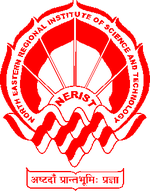North Eastern Regional Institute of Science and Technology
|
Emblem of NERIST | |
Motto in English | "The Confluence, the Region of Eight States" (translated) |
|---|---|
| Type | Public (Deemed University) |
| Established | 4 March 1984 |
| Director | Prof. H. S. Yadav |
Academic staff | 130 |
| Students | 1359 |
| Location |
Nirjuli, Papum Pare, Arunachal Pradesh, India 27°07′50″N 93°44′35″E / 27.13056°N 93.74306°ECoordinates: 27°07′50″N 93°44′35″E / 27.13056°N 93.74306°E |
| Colors |
Red |
| Athletics | Synergy |
| Affiliations | Ministry of Human Resource Development (India) |
| Website | nerist.ac.in |
North Eastern Regional Institute of Science and Technology (or NERIST) [1] is a science and technology oriented higher education institute in Nirjuli, Itanagar, in the Indian state of Arunachal Pradesh.[2] Established in 1984, it is a deemed university, autonomous, fully funded and controlled by the Ministry of Human Resource Development, Department of Education, Government of India.[3]
History
The beginning of North Eastern Regional Institute of Science and Technology was with a 1979 proposal by the Government of Arunachal Pradesh to establish a science and technology institute. A report prepared by a team of professors from the Indian Institute of Management, Ahmedabad in 1981–82, was submitted to the North Eastern Council (NEC) which approved it, paving the way to the registering of the society for the institute on 11 January 1983. NEC set up a working group headed by Amitabha Bhattacharya of Jadavpur University, which submitted a project report and a work plan on October 1983. The report was approved by the Ministry of Education in December that year,[4] though final approval from the Ministry of Education was on a letter dated 12 September 1985.
The foundation stone of the institute was set on 4 March 1984 by the President of India, Giani Zail Singh.[5] The institute started operating in 1986 with six base modules. Six diploma modules started in 1988 and by 1990 seven degree modules were added. The institute was funded by NEC until, on April 1994, it came directly under the full funding and control of the Ministry of Human Resource Development (MHRD). In May 2005 it was granted deemed university status.[5] NERIST gained approval for the postgraduate programme from AICTE and MHRD in 1996, and the latter was implemented by 2006.
The first Convocation of the institute, marking the Silver Jubilee celebration of the establishment of the institute, was held on 1 April 2009 in the presence of the President of India Pratibha Patil.[5] The Second Convocation was graced by the presence of former President of India Dr. A. P. J. Abdul Kalam held in August 2010. Besides the then Director of NERIST, Dr. Joram Begi, the State Governor of Arunachal Pradesh and president of NERIST Society, J. J. Singh and the Director of IIT Guwahati and Chairperson of NERIST Board of Management, Prof. Gautam Baruah were among the other dignitaries who had attended the occasion. Third Convocation of the institute was held on 12 October 2012 in the presence of Union Minister for Human Resource Development Kapil Sibal [6][7]
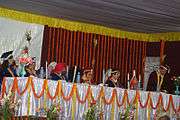 President of India Pratibha Patil(centre),Governor of Arunachal Pradesh J. J. Singh (left), Director of IIT Guwahati G. Baruah (right), former Director of NERIST J. Begi (standing), during First convocation.
President of India Pratibha Patil(centre),Governor of Arunachal Pradesh J. J. Singh (left), Director of IIT Guwahati G. Baruah (right), former Director of NERIST J. Begi (standing), during First convocation.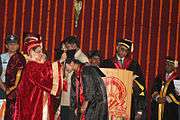 President of India Pratibha Patil honouring a student with gold medal during First Convocation, part of Silver Jubilee celebration at NERIST.
President of India Pratibha Patil honouring a student with gold medal during First Convocation, part of Silver Jubilee celebration at NERIST.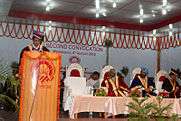 Former President of India A. P. J. Abdul Kalam (centre left), Governor of Arunachal Pradesh J. J. Singh (centre right), Director of IIT Guwahati G. Baruah (left), former Director of NERIST J. Begi (right).
Former President of India A. P. J. Abdul Kalam (centre left), Governor of Arunachal Pradesh J. J. Singh (centre right), Director of IIT Guwahati G. Baruah (left), former Director of NERIST J. Begi (right).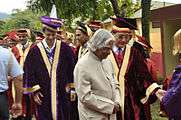 Former President of India A. P. J. Abdul Kalam (centre), Director of IIT Guwahati G. Baruah (left) and former Director of NERIST J. Begi (right).
Former President of India A. P. J. Abdul Kalam (centre), Director of IIT Guwahati G. Baruah (left) and former Director of NERIST J. Begi (right).
Chairperson of NERIST Society
| H.S. Dubey, IAS, Lt. Governor of Arunachal Pradesh | 11.01.1983 - 09.08.1983 |
| T. V. Rajeswar, IPS, Lt. Governor of Arunachal Pradesh | 10.08.1983 - 20.11.1985 |
| Shiv Swarup, IPS, Lt. Governor of Arunachal Pradesh | 21.11.1985 - 19.02.1987 |
| Bhisma Narain Singh, Governor of Arunachal Pradesh | 20.02.1987 - 18.03.1987 |
| R. D. Pradhan, IAS (Retd.), Governor of Arunachal Pradesh | 19.03.1987 - 16.03.1990 |
| Gopal Singh, Governor of Arunachal Pradesh | 17.03.1990 - 08.05.1990 |
| D. D. Thakur, Governor of Arunachal Pradesh | 09.05.1990 - 16.03.1991 |
| Loknath Misra, Governor of Arunachal Pradesh | 17.03.1991 - 25.03.1991 |
| S. N. Dwivedy, Governor of Arunachal Pradesh | 26.03.1991 - 04.07.1993 |
| Madhukar Dighe, Governor of Arunachal Pradesh | 05.07.1993 - 20.10.1993 |
| Mata Prasad, Governor of Arunachal Pradesh | 21.10.1993 - 16.05.1999 |
| S. K. Sinha, Governor of Arunachal Pradesh | 17.05.1999 - 01.08.1999 |
| Arvind Dave, Governor of Arunachal Pradesh | 02.08.1999 - 12.06.2003 |
| Vinod Chandra Pande, Governor of Arunachal Pradesh | 13.06.2003 - 15.12.2004 |
| S. K. Singh, Governor of Arunachal Pradesh | 16.12.2004 - 26.01.2008 |
| Gen. (Retd.) J. J. Singh, Governor of Arunachal Pradesh | 27.01.2008 - 28.05.2013 |
| Lt. Gen. (Retd.) Nirbhay Sharma, Governor of Arunachal Pradesh | 29.05.2013 - 12.05.2015 |
| Air Marshal (Retd.) Pranab Kumar Barbora | 13.05.2015–Present |
Location

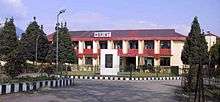
NERIST is located in Nirjuli in the Papum Pare district of Arunachal Pradesh in the foothills of the Eastern Himalayas. It is 19 km from Itanagar, the capital of Arunachal Pradesh, on National Highway 52A between Banderdewa and Itanagar. It is 10 km from Banderdewa, the border between Assam and Arunachal Pradesh, and about 390 km from Guwahati. The institute lies in the Capital-complex, consisting of (Itanagar, Naharlagun, Nurjuli and Banderdewa) and is accessible by road to the neighbouring cities of Assam.[8][9]
Campus

The national highway NH52 divides the NERIST campus into two. The institute is fully residential, and is spread over 500 acres of land. There are eight hostel blocks with a capacity of 1500 boarders; six of these house male undergraduate students, one postgraduate male students and research scholars and the other female students. The campus has faculty and staff quarters, guest houses, temple, church, namghar and a bank.
Organisation
The institute is managed by a Board of Management, comprising representatives of MHRD, the eight beneficiary states of the North Eastern region, AICTE and educationists. The state governor of Arunachal Pradesh is the de facto head of the highest body, NERIST Society, which consists of education ministers of all North Eastern States. The Board of Management is headed by the director of Indian Institute of Technology Guwahati, Gautam Baruah. The board appoints a well-known academic, generally from north east India, as director of NERIST.[10]
Each discipline has its own head of department, generally the most senior of the professors. The dean(s) for Student Affairs, Academic, Planning & Development and the Registrar oversee all other major activities.
The HMC is the house of management of all the hostels headed by the HMC chairperson. In addition to this, the administration is also run by the incharge/chairperson of Training and Placement (T&P) Cell, Education Technology (ET) Cell, Sports, Security, NCC/NSS unit, NERIST Entrance Examinations (NEE), Transport and Telecom.
Academic structure
The academic programme in Engineering and Technology is three modules, each of two years duration. These three modules — called Certificate, Diploma, and Degree — comprise the undergraduate studies. Each module has an entry point through an entrance examination conducted by NERIST. The first entry is after class X.[11]
Each module provides terminality corresponding to an occupational level and, at the same time, allows entry to the next higher module, leading to a degree in engineering and technology in about six years after class X. In the Applied Science stream, a two-year Base module and four year Degree module are offered. The system allows lateral entry from outside, at the beginning of each module.[11]
The Certificate and the Diploma levels emphasize the practical aspects of engineering, which help an individual become an entrepreneur or to face the day–to–day problems of industry. The Degree curriculum provides instruction not only in engineering but emphasizes management and entrepreneurship aspects as well.
Departments
The institute offers B. Tech, B.Sc., Diploma, Certificate, Management and Postgraduate programmes under following departments.[12]
- Agricultural Engineering[13]
- Civil Engineering[14]
- Computer Science and Engineering[15]
- Electrical Engineering[16]
- Electronics and Communication Engineering [17]
- Forestry and Life Sciences[18]
- Mechanical Engineering[19]
Besides the departments of core engineering and applied science disciplines, NERIST administers the following centres established within the institute -
- Centre of Appropriate Technology and Rural Development
- Centre for Management Studies
Besides, there are some departments that are auxiliary and do provide postgraduate courses viz Chemistry, Mathematics and Physics.
Admission
NERIST conducts the NERIST Entrance Exam (NEE) to select students for admission to Certificate, Diploma and Degree programmes. Three examinations, known as NEE-I, NEE-II and NEE-III, are held to take admissions at three levels. The NEE-I, for which eligibility is a pass in Class X, is held towards the end of April every year for admissions to the Base Module. NEE-II is for the lateral entry to the Diploma Module of Engineering and to the Degree Module of Applied Science stream and NEE-III is for the lateral entry to the Degree Module of Engineering. The notifications for NEE-I, II and III are published in most regional and national newspapers. NEEs are conducted in centers in the North Eastern States of India.[11][20]
Of the seats in each of the modules for direct admission, 80% of seats are reserved for the candidates of the eight states of the North East India (10% each) as states' quota. 7% of seats are filled up from the students of North East on merit. 10% of the seats are filled up by the candidates from rest of the States under the All India (AI) quota. 3% of the seats are reserved for physically handicapped candidates with 40-75% locomotor disability.[11]
Admission to the postgraduate programmes in technology is based on the performance of candidates in all India-level entrance examination GATE conducted by the IITs on behalf of the MHRD, Government of India. Separate entrance tests are conducted for admission to other postgraduate programmes.
Campus activities
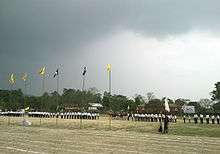
A student or an alumnus of NERIST is known as a NERISTian. A recreational programme associated with the culture of the college takes place around October called Sonabyss[21] including inter collegiate performances and lasting four days. Synergy is the annual athletic meet held in January or February when track and field athletic events are held. Football and cricket are the two most popular sports among the NERISTians.
The annual techno-management festival, called Shristi, is held along with RACAF.[22] Technical institutes from all over North Eastern India take part in this three-day fest. Shristi started as the technical-festival of NERIST in 2005 which has become the techno-management festival after the commencement of Management Studies at the institute. Shristi hosts events to build the interest of the audience in higher studies, including events for school children.[23][24]
NERIST bears NCC and NSS units.[25]
References
- ↑ "NERIST showcases in Arunachal Statehood Day, Assam Times". Assam Times News Bureau. 28 February 2012. Retrieved March 1, 2012.
- ↑ "Basic Information on Institutions of Higher and Technical Education, Arunachal Pradesh" (URL). Directorate of Higher and Technical Education, Govt. of Arunachal Pradesh, Itanagar. Retrieved 2011-11-20.
- ↑ "University and Higher Education - Annual Report" (PDF). MHRD, UGC. 2005–2006. pp. 210–211. Retrieved April 4, 2012.
- ↑ Maji, Debabrata (2005). "NERIST A Vision Of 21st Century Technical Education". In M. S. Reddy. Globalisation And Manpower Planning. Discovery Publishing House. pp. 13−36. Retrieved 24 March 2012.
- 1 2 3 "Speech by the President of India at First Convocation". RashtrapatiBhavan. Retrieved 2011-11-16.
- ↑ "Dr Kalam arrives on 2-day Arunachal visit". The Assam Tribune. Retrieved April 3, 2012.
- ↑ "Dr. Kalam to attend convocation". The Telegraph. Retrieved April 3, 2012.
- ↑ "NERIST, Location". Retrieved April 3, 2012.
- ↑ "Govt to regulate growth and development of urban and regional areas: Tuki". The Arunachal Times. August 23, 2009. Retrieved April 4, 2012.
- ↑ "NERIST should become best technical institute of the country". The Arul,l,l[nachal Times. January 6, 2012. Retrieved April 11, 2012.
- 1 2 3 4 "Admission structure". NERIST. Retrieved April 9, 2012.
- ↑ http://nerist.ac.in/tnp/about_nerist.html#departments
- ↑ http://nerist.ac.in/department/agriculture/faculty/
- ↑ http://nerist.ac.in/department/civil/faculty/
- ↑ http://nerist.ac.in/department/computer/faculty/
- ↑ http://nerist.ac.in/department/electrical/faculty/
- ↑ http://nerist.ac.in/department/electronics/faculty/
- ↑ http://nerist.ac.in/department/forestry/faculty/
- ↑ http://nerist.ac.in/department/mechanical/faculty/
- ↑ "NERIST entrance 2012". Retrieved April 4, 2012.
- ↑ "Sonabyss 2011 official website". NERIST. Archived from the original on 2012-04-25. Retrieved 2011-11-20.
- ↑ "Techno-Management Festival Inaugurated in Arunachal". Northeast Today. April 2, 2012. Retrieved April 4, 2012.
- ↑ "Shristi 2012 official site". Retrieved April 3, 2012.
- ↑ "NERIST set to host SHRISTI-2012". Echo of Arunachal. March 28, 2012. Retrieved April 4, 2012.
- ↑ "NSS camp at NERIST". The Arunachal Times. August 23, 2009. Retrieved April 4, 2012.
External links
| Wikimedia Commons has media related to North Eastern Regional Institute of Science and Technology. |
